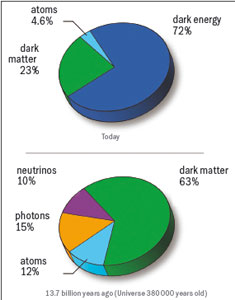After five years observing the oldest light in the universe, NASA’s Wilkinson Microwave Anisotropy Probe (WMAP) is refining our understanding of the universe. It finds evidence for cosmic neutrinos permeating the universe and discriminates models for the burst of expansion in the universe’s first fraction of a second.
Each cubic centimetre of space contains about 400 photons from the Cosmic Microwave Background (CMB). They come from all directions in space but from a given time about 380,000 years after the Big Bang. It is the time of decoupling of light and matter making the universe transparent to radiation. The decoupling results from the formation of the first atoms by the combination of electrons and protons. Although the CMB is almost uniform on the sky, its pattern of very small fluctuations in intensity can be analysed to derive the universe’s age, composition and development.

Credit: NASA/WMAP Science Team.
The first three years of WMAP data already provided accurate measurements of the main cosmological parameters (CERN Courier May 2006 p12). On 7 March the WMAP science team released an update of these results with the addition of two years of data acquisition and improved calibration. The gain in sensitivity – which scales with the square root of observing time – being only a factor 1.3, it is not surprising that the new results do not drastically change the findings published two years ago. They confirm with increased precision the standard model of cosmology. In this so-called ΛCDM model, the present energy content of the universe is dominated by dark energy with an equation of state suggesting a pure cosmological constant (w = –0.97±0.06) and cold dark matter (CDM) of unknown nature. Their contribution to the energy content of the present universe is of 72±2% and 23±1%, respectively, the remaining being essentially "ordinary" baryonic matter accounting for 4.6±0.2%. The contribution from neutrinos is currently less than 1%, but used to be much higher (around 10%) when the CMB light was emitted.
The existence with greater than 99.5% confidence of such a "cosmic neutrino background" from the early universe is a new result from WMAP. Its presence influences the fluctuations of the CMB on the smallest angular scales that are now more accurately measured. The second main finding from the new WMAP data is a refined determination of the epoch of reionization of the universe by the first stars found to have occurred at a redshift of z = 10.8±1.4, about 400 million years after the Big Bang. Finally, various possible inflation scenarios are also better constrained now by a more accurate determination of the scalar spectral index found to be n = 0.960±0.014, meaning a small but significant deviation from scale-invariant density fluctuations.
WMAP is still operating and continuously observing the CMB radiation first identified in 1965 by Arno Penzias and Robert Wilson, who were jointly awarded the Nobel Prize in 1978. The breakthrough of WMAP was to show that the content and evolution of the universe can be derived from the CMB with great precision. ESA’s Planck mission to be launched at the end of the year shall soon take over and further refine our understanding of the cosmos.
• The quoted values are derived from WMAP data with additional constraints from Type-Ia supernovae and from the large-scale distribution of galaxies.








